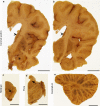α-Synucleinopathy associated with G51D SNCA mutation: a link between Parkinson's disease and multiple system atrophy?
- PMID: 23404372
- PMCID: PMC3681325
- DOI: 10.1007/s00401-013-1096-7
α-Synucleinopathy associated with G51D SNCA mutation: a link between Parkinson's disease and multiple system atrophy?
Abstract
We report a British family with young-onset Parkinson's disease (PD) and a G51D SNCA mutation that segregates with the disease. Family history was consistent with autosomal dominant inheritance as both the father and sister of the proband developed levodopa-responsive parkinsonism with onset in their late thirties. Clinical features show similarity to those seen in families with SNCA triplication and to cases of A53T SNCA mutation. Post-mortem brain examination of the proband revealed atrophy affecting frontal and temporal lobes in addition to the caudate, putamen, globus pallidus and amygdala. There was severe loss of pigmentation in the substantia nigra and pallor of the locus coeruleus. Neuronal loss was most marked in frontal and temporal cortices, hippocampal CA2/3 subregions, substantia nigra, locus coeruleus and dorsal motor nucleus of the vagus. The cellular pathology included widespread and frequent neuronal α-synuclein immunoreactive inclusions of variable morphology and oligodendroglial inclusions similar to the glial cytoplasmic inclusions of multiple system atrophy (MSA). Both inclusion types were ubiquitin and p62 positive and were labelled with phosphorylation-dependent anti-α-synuclein antibodies In addition, TDP-43 immunoreactive inclusions were observed in limbic regions and in the striatum. Together the data show clinical and neuropathological similarities to both the A53T SNCA mutation and multiplication cases. The cellular neuropathological features of this case share some characteristics of both PD and MSA with additional unique striatal and neocortical pathology. Greater understanding of the disease mechanism underlying the G51D mutation could aid in understanding of α-synuclein biology and its impact on disease phenotype.
Figures








References
Publication types
MeSH terms
Substances
Grants and funding
LinkOut - more resources
Full Text Sources
Other Literature Sources
Medical
Miscellaneous

